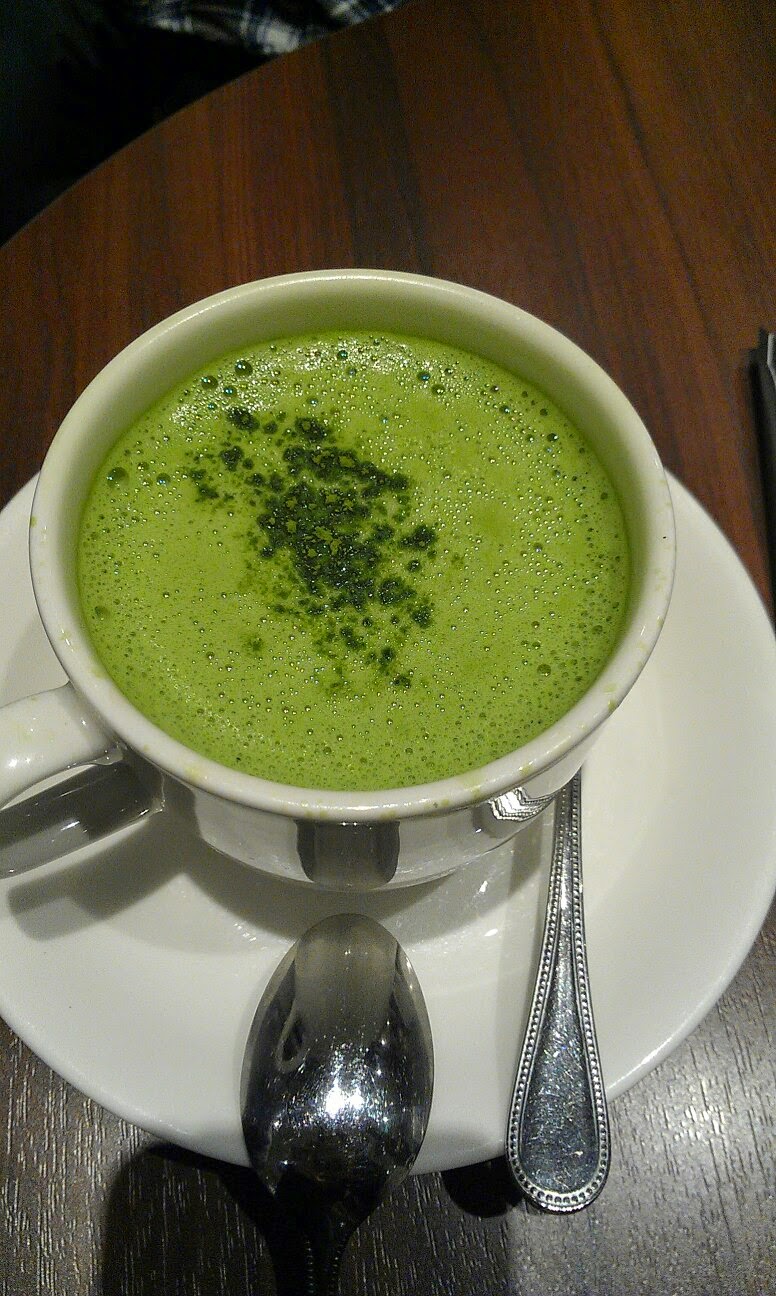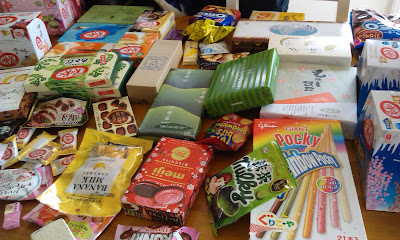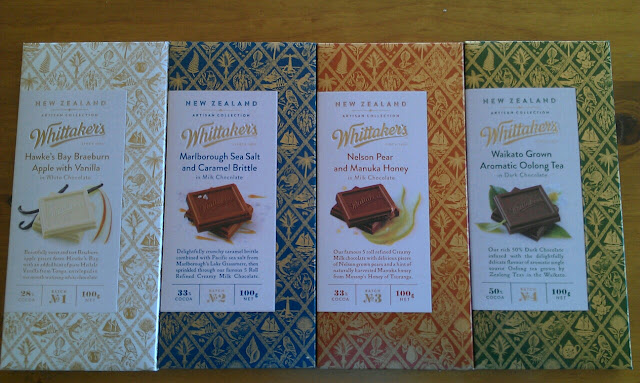Osaka : Osaka Castle, History Museum, Doguyasuji, Dotonbori, Kaiten-Zushi
Day Eight
BREAKFAST : DOUTOR COFFEE
The hotel in Osaka was the Hearton Hotel, located about five minutes' walk from Osaka and Umeda stations. As breakfast was not included with the rooms we were to look for something outside the hotel, and in the shopping building between the hotel and the station one was opened in the time we agreed to eat: Doutor Coffee. It wasn't the cheapest fast food we'd had, totalling over ¥4,000 for five, though this included a sandwich or croissant and a hot drink each, and an extra chocolate mille crepe on the side.I opted for a drink I knew I wouldn't find elsewhere: the matcha latte had the typical bitter after-taste of a good green tea powder, but the sweetness and creaminess from the milk balanced it out to a very enjoyable drink.
 |
| Matcha latte |
OSAKA AMAZING PASS
Osaka offers a couple of passes which give tourists discounts when staying in the city. We opted for the two-day Osaka Amazing Pass at ¥3,000 per person (¥2,300 for the one-day pass), which allowed us access on all trains (excluding JR train lines), buses, and entry to many of Osaka's landmarks and tourist sites without extra fees. With proper research and set decisions for which landmarks to see, the Amazing Pass can save a great deal of money.
The Pass itself acts as a ticket which is run through the machines allowing entrance to train platforms, or the ticket presented and the barcode scanned for local sights. This is to prevent re-entry into the tourist spots so that tickets cannot be shared.
I found that the trains in Osaka are much easier to use than those in Tokyo (or at least it's the case for local lines). Fashioned more similarly to Singapore and Hong Kong's subway lines, one platform heads in one direction, and as there are no express trains guarantees that it stops at every station, removing the possibility of missing an intended stop.
OSAKA CASTLE MUSEUM
The castle grounds is about ten minutes' walk from Tanimachi Yon-Chome (or 4-Chome) station. In Osaka, many of the stations have maps with labelled exits, and often list which exit one should take in order to reach a tourist spot. This meant that we didn't need to ask questions of our whereabouts, making orientating ourselves a lot easier.
Like the other castles, the Osaka Castle grounds are huge. It took some time to locate the entrance, and the tickets were not required up until the entrance of the castle itself, allowing many tourists to take photos outdoors and at very close proximity. Many attractions surround the castle's main building, including souvenir shops, food trucks, and even entertainers.
 |
| A pigeon-whisperer, with pigeons sitting upon his head |
Osaka Castle itself, however, was not as we expected. Unlike the other castles, whose interiors were refurbished to maintain the historical feel, Osaka Castle has been completely renovated into a modernised museum, complete with labelled exhibitions and elevators. We agreed unanimously that it was a disappointing experience, and we learned in the castle the reason for its state.
 |
| The main building |
In the 1600s, lightning struck the castle, causing an explosion, and later that century another strike burned the main building. After a successful restoration in the 1920s, it was destroyed again during WWII, so after (what I suppose) a lot of frustration and anger, it was rebuilt entirely into something more.... durable. The museum itself is interesting - if you have the patience to read through the plaques and study the exhibits, more information can be gathered from the Osaka Castle Museum and the history of the Japanese royal families than the other castles. That, along with the refurbished building making it a place with good accessibility, but it's hardly the place to go for the feel of a historic Japanese castle. If there's only one castle on your itinerary I wouldn't suggest the Osaka castle.
 |
| View from the top: not noticeable from outside, the top has scaffolding, presumably to prevent people from falling or to help with structure |
OSAKA MUSEUM OF HISTORY
The Museum of History is across the road from the castle, heading back in the direction of Tanimachi 4-Chome station. Also covered by the Amazing Pass, its location made it a convenient local attraction to visit.
 |
| Outside the building, reminding my family a bit of NZ's Te Papa Museum |
LUNCH : MOS BURGER
Heading back to the station, I spotted a MOS Burger near one of the many entrances, so we decided to stop for lunch. The outdoor menu had no English, which resulted in my family relying on me for as many translations as possible, but when it came to ordering the lady at the counter produced an English menu which we pointed at for easy communication. Lunch was around ¥4,000 for the five of us.
Amongst our orders is the standard MOS Burger with salad, a prawn cutlet burger, and a teriyaki burger. Though the burger itself isn't all too big, the fries and drink made for a decent meal. The MOS Burger has a special sauce in it that tastes like spaghetti sauce (an excellent selection). A sad amount of onion rings in our onion-ring-and-potato-fry orders (two). Better off getting either the fries or the onion rings alone.
NAMBA AREA
Namba (or Nanba) area, surrounding Namba station, holds many good shopping and eating places, making it ideal for the average tourist. Shops include fashion giants like Forever 21 and H&M, smaller fashion chain stores, drugstores (selling iconic Japanese drugstore cosmetics), and, of course, eateries every other shop. Takoyaki stands litter the streets every twenty metres, meaning one will never go hungry here.DOGUYASUJI
Doguyasuji is a famous shopping street focused on kitchenwares. The stores along the street stock things ranging from novel items to large appliances, basic needs to industrial machines, and cooking utensils to eating cutlery. For anyone with an interest in cooking, or just looking for a gift idea, it's an excellent place to stop by.Edible goods are also on sale.
 |
| Industrial-sized, machine-powered whisks about 80cm long |
 |
| Individulally wrapped jelly beans |
DOTONBORI
Dotonbori is famous in the Namba area for food and excess. There are possibly hundreds of different eateries, whether to sit down for a hearty meal or to stop off for a snack. Dotonbori also boasts the infamous Glico man, a giant billboard promoting Glico, a Japanese food brand, which grew so popular from its bizarre presence to attract tourists it became iconic to the area. |
| Glico Man: A must-see |
Dotonbori stores also promote their wares using the most ostentatious signs imaginable.
 |
| The limbs and eyes move |
 |
| On the sign: Andrew's Egg Tarts. Makes for good dessert when hot! |
 |
| Kaiten-zushi restaurant where we had dinner (see below) |
DINNER : KAITEN-ZUSHI
Due to the immense number of options in Dotonbori, it became an obvious choice as the place to have dinner. So, after staking out the area we settled for a kaiten-zushi (conveyor-belt sushi) shop, where each plate is sold at a set ¥100 each (¥108 including tax). On the main Dotonbori road and with a large queue, we figured it was a good stop, so we joined the line (sending Dad and me for takoyaki in the time during), and waited patiently. The wait was relatively short, as the restaurant is designed to be a quick-stop meal. |
| The labels are in Japanese, meaning a translator app and guesses made up most of the meal. |
A rule in kaiten-zushi we weren't aware of that pointing using chopsticks, or bringing it too close to the selection, is considered rude and unhygienic, and if you do so it's required you take the plate. We were given a sharp warning when we did this unknowingly.
We learned quickly that the location of kaiten-zushi shops doesn't necessarily guarantee quality - it had been a very spur-of-the-moment decision to eat there, as we previously had had no intention of eating sushi in the middle of Japanese winter. The sushi available in the restaurant had very average quality, so much so that we'd had better and fresher fish in NZ. If kaiten-zushi is on your itinerary, it is highly suggested that research is taken to ensure the restaurant chosen sells good, fresh sushi.
Following dinner was some more shopping, and after, we returned to the hotel, bringing an end to Day 8.













Comments
Post a Comment